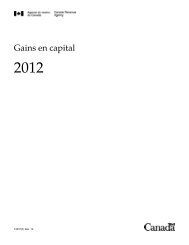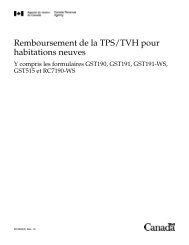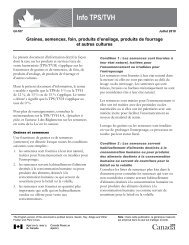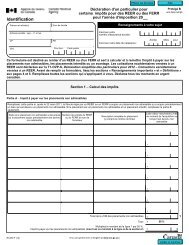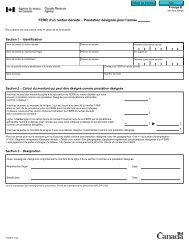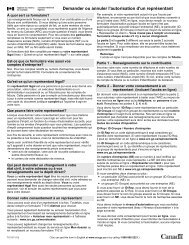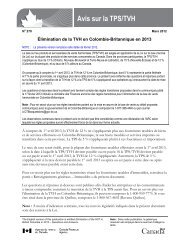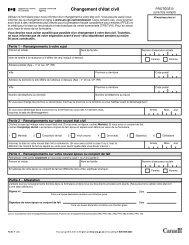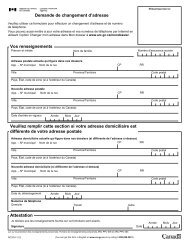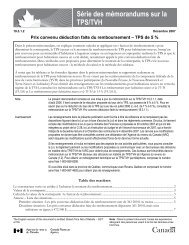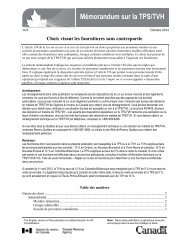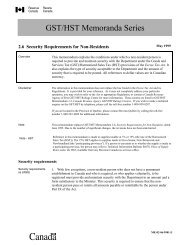CRA Annual Report to Parliament 2011-2012 (PDF - Agence du ...
CRA Annual Report to Parliament 2011-2012 (PDF - Agence du ...
CRA Annual Report to Parliament 2011-2012 (PDF - Agence du ...
Create successful ePaper yourself
Turn your PDF publications into a flip-book with our unique Google optimized e-Paper software.
(iv) Assessment – definition:<br />
An assessment (or reassessment) of tax includes all decisions and other steps made or taken by the Minister of<br />
National Revenue and officials of the <strong>CRA</strong> under the federal, provincial, and terri<strong>to</strong>rial acts or sections of the acts the<br />
<strong>CRA</strong> administers <strong>to</strong> calculate tax payable by taxpayers. When verifying a taxpayer’s return, the <strong>CRA</strong> uses the various<br />
tax acts it administers and other criteria it developed that are designed <strong>to</strong> substantially meet the provisions of these<br />
acts.<br />
Reassessments include changes <strong>to</strong> previously assessed taxes payable at the request of the taxpayer, for example <strong>to</strong><br />
claim a subsequent loss carry-back, or changes the <strong>CRA</strong> initiated as a result of applying proce<strong>du</strong>res <strong>to</strong> verify<br />
reporting compliance, such as taxpayer audits.<br />
(v) Completeness of tax revenues:<br />
The Canadian tax system is based on self-assessment, so taxpayers are expected <strong>to</strong> understand the tax laws and<br />
comply with them. This has an impact on the completeness of tax revenues when taxpayers fail <strong>to</strong> comply with tax<br />
laws, for example, if they do not report all of their income. The <strong>CRA</strong> has implemented systems and controls <strong>to</strong><br />
detect and correct situations where taxpayers are not complying with the various acts it administers. These systems<br />
and controls include audits of taxpayer records when the <strong>CRA</strong> decides they are necessary, but these proce<strong>du</strong>res<br />
cannot be expected <strong>to</strong> identify all sources of unreported income or other cases of non-compliance with tax laws.<br />
The <strong>CRA</strong> is unable <strong>to</strong> estimate the amount of unreported tax.<br />
(b) Expenses<br />
(i) Interest expense:<br />
The <strong>CRA</strong> has <strong>to</strong> pay interest when it pays refunds late. These refunds arise largely from the resolution of longstanding<br />
corporate tax files in favour of the taxpayer. Interest is accrued from the date that the tax instalment was<br />
initially paid <strong>to</strong> the date that the case is resolved. The <strong>CRA</strong> records the interest expense in the fiscal year it relates <strong>to</strong>.<br />
(ii) Administered expenses:<br />
Expenses relating <strong>to</strong> child tax benefits, universal child care benefits, children’s special allowances, and provincial<br />
and terri<strong>to</strong>rial administered expenses are recorded in the year they relate <strong>to</strong>, based on when the recipients were<br />
entitled <strong>to</strong> receive the benefit or the allowance. Transfers <strong>to</strong> provinces for the softwood lumber pro<strong>du</strong>cts export<br />
charge are recorded as an expense in the same year that the related softwood lumber pro<strong>du</strong>cts export charge<br />
revenues are recognized.<br />
(iii) Administered recoveries:<br />
Recoveries of old age security and EI benefits are recognized when assessed. Amounts not yet assessed are<br />
estimated. The <strong>CRA</strong> reports only recoveries assessed through the indivi<strong>du</strong>al income tax system. Recoveries<br />
determined by other federal government departments are not reported in these financial statements.<br />
(c) Cash on hand<br />
Cash on hand refers <strong>to</strong> amounts received in the <strong>CRA</strong>’s offices or by its agents up <strong>to</strong> March 31 but not yet deposited <strong>to</strong> the<br />
credit of the Consolidated Revenue Fund of the Government of Canada.<br />
(d) Amounts receivable from taxpayers<br />
Amounts receivable from taxpayers include taxes, interest, penalties, and other revenues assessed or estimated by the<br />
<strong>CRA</strong> but not yet collected. A significant portion of the receivable balance results from recording accrued receivables that<br />
relate <strong>to</strong> the current fiscal year but are not <strong>du</strong>e <strong>to</strong> be paid by taxpayers until the next fiscal year.<br />
(e) Allowance for doubtful accounts<br />
The allowance for doubtful accounts is management’s best estimate of the collectability of amounts that have been<br />
assessed, including the related interest and penalties, but not yet paid. The allowance for doubtful accounts has two<br />
components. A general allowance is calculated based on the age of the accounts. A specific allowance is calculated<br />
based on an annual review of all accounts over $10 million.<br />
The allowance for doubtful accounts is adjusted every year through a provision for doubtful accounts and is re<strong>du</strong>ced by<br />
amounts written off as uncollectible <strong>du</strong>ring the year. The annual provision is reported in the Statement of Administered<br />
ANNUAL REPORT<br />
<strong>2011</strong>-<strong>2012</strong><br />
CANADA REVENUE AGENCY



